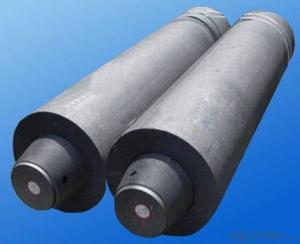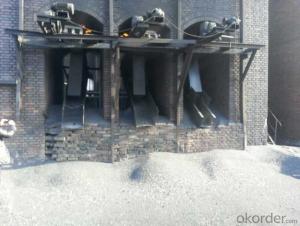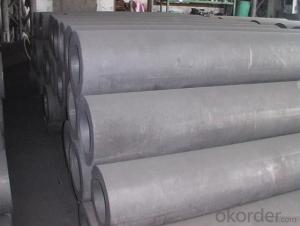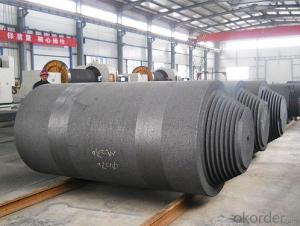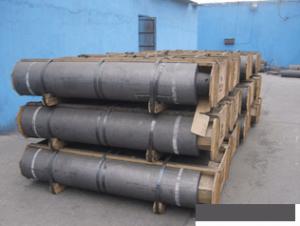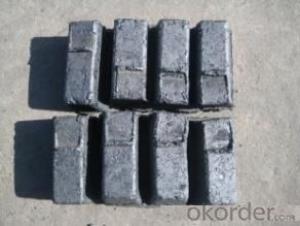Carbon Electrode With High And Stable Quality
- Loading Port:
- Tianjin
- Payment Terms:
- TT OR LC
- Min Order Qty:
- 20 m.t.
- Supply Capability:
- 800 m.t./month
OKorder Service Pledge
OKorder Financial Service
You Might Also Like
Carbon Electrode With High And Stable Quality
Product Description
Carbon Electrode is abaked electrode used in submerged arc furnaces for delivering power to the charge mix. Electrode is added to the top of the electrode column cylindrical form. Electrode is essentially a mix of Electrically Calcined Anthracite (ECA) or Calcined Petroleum Coke (CPC) with Coal Tar Pitch and is baked for weeks, it is widly used for ferroally productiong, silicon metal production etc.
Features
1:carbon eletrode
2:for ferroalloy,calcium carbide, silicon metal, manufacture
Graphite/Carbon Electrode Paste Specification
| PARAMETER UNIT GUARANTEE VALUE | ||||||
| Items | Φ500~Φ700 | Φ750~Φ960 | Φ1020~Φ1400 | |||
| Rs μΩ.m | ≤45 | ≤38 | ≤45 | ≤38 | ≤40 | |
| Bulk Desity g/cm3 | ≥1.55 | ≥1.58 | ≥1.55 | ≥1.58 | ≥1.55 | ≥1.58 |
| Bending Strength MPa | 3.5~7.5 | 4.0~7.5 | 3.5~7.5 | 4.0~7.5 | 3.5~7.5 | 4.0~7.5 |
| Compressive Strength MPa | ≥20.0 | ≥20.0 | ≥20.0 | ≥20.0 | ≥19.0 | ≥19.0 |
| Compressive Strength MPa | 3.2~4.8 | 3.0~4.6 | 3.2~4.8 | 3.0~4.6 | 3.2~4.8 | 3.0~4.6 |
| Ash % | ≤2.5 | ≤2.0 | ≤2.5 | ≤2.0 | ≤2.5 | ≤2.0 |
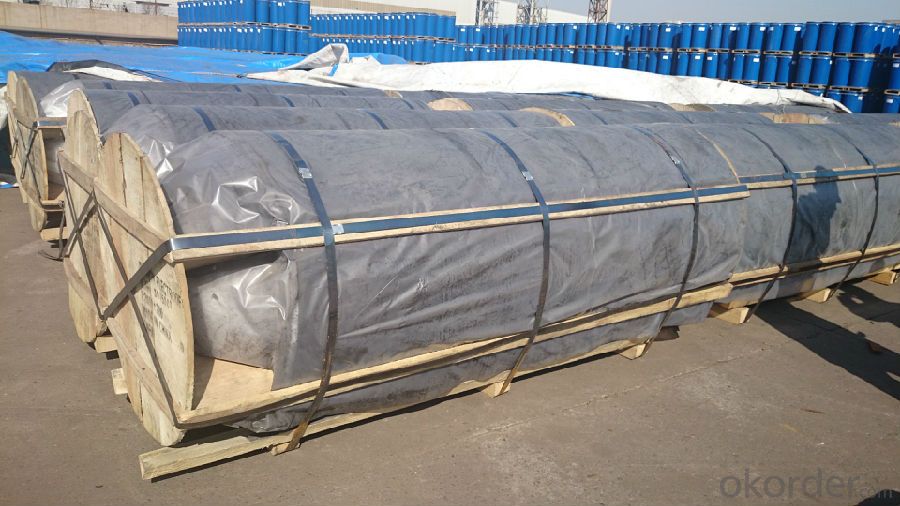
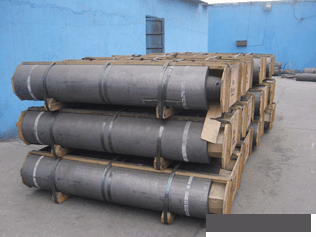
We Also supply all kind of carbon electrode paste and below materials, please contact us if you have any enquiry about it.
Calcined Anthracite
Calcined Petroleum Coke
Coke (Met Coke, Foundry Coke, Semi Coke)
- Q: What are carbon credits and how do they work?
- Carbon credits are a market mechanism designed to reduce greenhouse gas emissions. They work by assigning a monetary value to each ton of carbon dioxide or other greenhouse gases that are not released into the atmosphere. This value is assigned through a process called carbon offsetting, which involves investments in projects that reduce emissions, such as renewable energy projects or reforestation initiatives. These projects generate carbon credits, which can be bought and sold by companies or individuals to offset their own emissions. By purchasing carbon credits, entities can effectively compensate for their own carbon footprint and contribute to global efforts in mitigating climate change.
- Q: Why is carbon content of stainless steel low?
- [stainless steel contains low carbon content] stainless steel contains very high Cr. Cr and carbon combine to form carbides, Cr23C6 or Cr7C3, which contain very high Cr. That is, the formation of these carbides is at the expense of a large amount of Cr. It is conceivable that once the content of Cr in the matrix drops a lot, the corrosion resistance will decrease. For austenitic stainless steel, due to the precipitation of Cr carbide, its intergranular corrosion resistance has deteriorated significantly, which is called sensitization.Martensitic stainless steels contain relatively large amounts of carbon.
- Q: How are carbon nanomaterials used in electronics?
- Carbon nanomaterials, such as carbon nanotubes and graphene, are used in electronics due to their exceptional electrical and thermal properties. They can be used as conductive additives in electronic devices, enabling faster and more efficient electron transport. Carbon nanomaterials are also used as transistors, making it possible to build smaller and more powerful electronic components. Additionally, their high surface area and mechanical strength make them suitable for energy storage devices like batteries and supercapacitors. Overall, carbon nanomaterials play a crucial role in enhancing the performance and miniaturization of electronic devices.
- Q: How do fossil fuels release carbon dioxide when burned?
- By burning fossil fuels, carbon dioxide (CO2) is released as a byproduct. This occurrence is a result of the chemical makeup of fossil fuels. Fossil fuels, including coal, oil, and natural gas, primarily consist of hydrocarbons, which are compounds made up of carbon and hydrogen atoms. During the process of combustion, these hydrocarbons undergo a reaction with oxygen (O2) present in the air, leading to the production of carbon dioxide and water vapor. The chemical equation for the combustion of a hydrocarbon fuel, like the octane found in gasoline, can be represented as follows: C8H18 + 12.5O2 → 8CO2 + 9H2O In this reaction, each molecule of octane (C8H18) combines with 12.5 molecules of oxygen (O2) to yield 8 molecules of carbon dioxide (CO2) and 9 molecules of water (H2O). The carbon atoms contained within the hydrocarbons of fossil fuels bond with oxygen to create carbon dioxide. This release of carbon dioxide into the atmosphere is what contributes to the greenhouse effect and global warming. The combustion of fossil fuels serves as a significant source of anthropogenic (human-caused) carbon dioxide emissions, making up a substantial portion of the greenhouse gases discharged into the atmosphere. It is important to acknowledge that the burning of fossil fuels also results in the release of other harmful pollutants, such as sulfur dioxide (SO2) and nitrogen oxides (NOx), which have detrimental effects on air quality and human health. To address the adverse impacts of fossil fuel combustion, endeavors are underway to develop cleaner and more sustainable sources of energy, such as renewable energy, in order to diminish our reliance on fossil fuels and decrease carbon dioxide emissions.
- Q: Buy carbon carving, how to identify him is true or false, and the quality of good or bad?
- Most consumers think the difference between "Zijin carbon carving" and activated carbon is a cheap, a noble, a beautiful, a dirty, in fact they have a completely different function, "Zijin carbon carving at least three point is beyond the powder activated carbon.One is "up to 100 times longer and even thousands of times the Zijin carbon carving" activated carbon powder than life, there is a gap between the granular activated carbon powder, the gap will be preferential adsorption of water vapor, in one to two months (the South may be less than half a month) to form a hydrophilic outer shell thus, lost its adsorption function, and the "Zijin carbon carving" the large volume high fine carbon, molecular absorption pressure technology of gapless combined, and through the fine carbon activation activation of the "Zijin carbon carving" internal logic array pore formation, through carbonization and activation, pore forming process makes "Zijin carbon carving" to achieve through the hole directional adsorption of formaldehyde, benzene and other toxic and harmful gases but also through the large hole directional water vapor, but also through the hole directional adsorption of radiation, thereby greatly prolonging the service life.Second is the powder activated carbon particles easily suspended in the indoor air, forming second pollution, and "Purple carbon carving" seamless seamless activated carbon sublimation products, no pollution second times.Third, "Purple carbon carving" has an elegant artistic form. It is an ideal decoration for home and office, and the purification effect is more thorough
- Q: What's the difference between an alkaline cell and a carbon cell?
- Alkaline batteries, also known as alkaline dry cells, alkaline manganese dioxide batteries and alkaline manganese batteries, are among the best in the range of zinc manganese batteries. The utility model is suitable for large discharge capacity and long time use. The internal resistance of the battery is low, so the current produced is larger than that of the general manganese battery, while the environmental friendly mercury content is only 0.025%. A carbon cell belongs to a primary battery in a chemical power supply and is a disposable battery. Because the chemical power unit has an electrolyte that is a non flowing paste, it is also called a dry cell, as opposed to a battery with a flowing electrolyte. Carbon battery is not only suitable for the flashlight, radios, tape recorders, cameras, semiconductor, electronic clocks, toys and other fields, but also for national defense, scientific research, telecommunication, navigation, aviation, medicine, etc. in the national economy.
- Q: What is carbon pricing?
- The concept of carbon pricing involves assigning a monetary value to carbon dioxide and other greenhouse gas emissions in order to decrease their release into the atmosphere. This is achieved by placing a price on the carbon content of fossil fuels and other activities that produce greenhouse gases. The main goal of carbon pricing is to motivate businesses, industries, and individuals to reduce their carbon emissions by making cleaner and more sustainable practices economically favorable. There are two primary approaches to carbon pricing: carbon taxes and cap-and-trade systems. A carbon tax establishes a fixed price per ton of carbon emissions, which businesses and industries must pay based on their emission levels. This tax acts as a financial incentive for companies to decrease their emissions in order to avoid higher costs. Conversely, cap-and-trade systems set a limit, or cap, on the total amount of emissions allowed within a specific time frame. Companies are then given a certain number of emissions permits, which they can buy, sell, or trade with other companies. This system creates an emissions market, where companies that can easily reduce their emissions can sell their excess permits to those struggling to meet their targets. The revenue generated from carbon pricing can be utilized in various ways. It can be reinvested into renewable energy projects, initiatives for energy efficiency, or research and development of clean technologies. Additionally, it can be used to support vulnerable communities affected by the transition to a low-carbon economy or to mitigate the economic impacts on industries that may face challenges in reducing their emissions. Carbon pricing is regarded as an effective tool for addressing climate change, as it provides a clear economic signal to businesses and individuals to decrease their carbon footprint. By placing a price on carbon, it internalizes the costs associated with climate change and encourages the adoption of cleaner alternatives. Furthermore, it helps level the playing field between polluting industries and those investing in low-carbon technologies, creating an incentive for innovation and the advancement of sustainable practices.
- Q: What does carbon cloth tonnage mean?
- Carbon cloth tonnage is illegal: mean a square centimeter of sectional area of carbon cloth tension of tonnage. Meaning that the carbon cloth rolled into a solid "rod" if the cross-sectional area of the bar is 1 cm, the maximum tension tonnage it bear -- carbon cloth tonnage.
- Q: What is the primary source of carbon monoxide in the atmosphere?
- The primary source of carbon monoxide in the atmosphere is the incomplete combustion of fossil fuels. When fossil fuels like coal, oil, and natural gas are burned for energy production, vehicles, or industrial processes, carbon monoxide is released into the air. In addition to human activities, natural sources such as volcanic eruptions and forest fires can also contribute to the presence of carbon monoxide in the atmosphere. However, the majority of carbon monoxide emissions can be attributed to human activities, making it an important air pollutant to address in order to protect human health and the environment.
- Q: The same manufacturer of different types of badminton rackets on the logo, but the two materials in the end what is the difference?
- Under the same force, high elasticity means that the elongation of the fiber is relatively large, and the high rigidity means that the elongation is relatively small.The racket hit the ball using high elastic fiber can withstand greater deformation, good toughness, a slowerThe racket hit the ball using high rigid fibers during deformation is small, hit the ball faster.
Send your message to us
Carbon Electrode With High And Stable Quality
- Loading Port:
- Tianjin
- Payment Terms:
- TT OR LC
- Min Order Qty:
- 20 m.t.
- Supply Capability:
- 800 m.t./month
OKorder Service Pledge
OKorder Financial Service
Similar products
Hot products
Hot Searches
Related keywords
